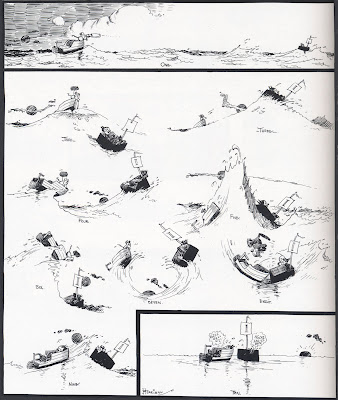
In one of his most famous sonnets, Shakespeare claims that true love is the permanent thing, the polar star by which we can all guide our ship. Love, he explains, never alters its path no matter what kind of impediment it encounters:
Let me not to the marriage of true mindsBut here is an opposite view from Yeats. For him, love is crooked and bewildering. And you can forget about that polar star business, love will continue to drive us nuts until those stars have all gone out:
Admit impediments. Love is not love
Which alters when it alteration finds,
Or bends with the remover to remove:
O no! it is an ever-fixed mark
That looks on tempests and is never shaken;
It is the star to every wandering bark [ship]....
O love is the crooked thing,The following episode from the ongoing love/hate saga of Krazy Kat and Ignatz mouse shows Ignatz determined to overcome all obstacles and consummate a brick toss:
There is nobody wise enough
To find out all that is in it,
For he would be thinking of love
Till the stars had run away
And the shadows eaten the moon.

Notice how Herriman has provided us with a polar star to make sense of the visual pandemonium. That sun appears to bounce up and down on the horizon, but we soon realize that it is the horizon (along with everything else in the picture) that is bouncing around. The sun is the only thing that remains constant. It is the fixed reference point that gives these drawings the continuity necessary for us to figure out what the heck is going on:





Herriman doesn't side with either Shakespeare or Yeats. Artists speak in pictures rather than words, so Herriman does not need to worry about reconciling the two conflicting texts. Leave that dirty work to poets and lawyers. Pictures enjoy an ambivalence (and a truth) that words can't match; Herriman depicts an undeterrable Ignatz and a polar star such as Shakespeare might expect, but any love that involves being brained by a brick probably belongs on one of those crooked corners Yeats describes.
Herriman does contribute the insight that sometimes the only resolution of conflicts is found in the limp exhaustion of the couple (whether from happy activity or sad).

No comments:
Post a Comment